
Aquitaine, archaic Guyenne or Guienne, is a historical region of southwestern France and a former administrative region of the country. Since 1 January 2016 it has been part of the region of Nouvelle-Aquitaine. It is situated in the southwest corner of Metropolitan France, along the Atlantic Ocean and the Pyrenees mountain range on the border with Spain, and for most of its written history Bordeaux has been a vital port and administrative center. It is composed of the five departments of Dordogne, Lot-et-Garonne, Pyrénées-Atlantiques, Landes and Gironde. Gallia Aquitania was established by the Romans in ancient times and in the Middle Ages, Aquitaine was a kingdom and a duchy, whose boundaries fluctuated considerably.

Charles the Bald, also known as Charles II, was a 9th-century king of West Francia (843–877), king of Italy (875–877) and emperor of the Carolingian Empire (875–877). After a series of civil wars during the reign of his father, Louis the Pious, Charles succeeded, by the Treaty of Verdun (843), in acquiring the western third of the empire. He was a grandson of Charlemagne and the youngest son of Louis the Pious by his second wife, Judith.

Louis VII, called the Younger, or the Young, was King of the Franks from 1137 to 1180. He was the son and successor of King Louis VI and married Duchess Eleanor of Aquitaine, one of the wealthiest and most powerful women in western Europe. The marriage temporarily extended the Capetian lands to the Pyrenees.
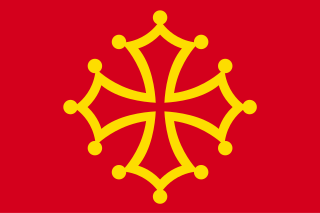
The County of Toulouse was a territory in southern France consisting of the city of Toulouse and its environs, ruled by the Count of Toulouse from the late 9th century until the late 13th century.

William I, called the Pious, was the Count of Auvergne from 886 and Duke of Aquitaine from 893, succeeding the Poitevin ruler Ebalus Manser. He made numerous monastic foundations, most important among them the foundation of Cluny Abbey on 11 September 910.

The Duchy of Aquitaine was a historical fiefdom in western, central, and southern areas of present-day France to the south of the river Loire, although its extent, as well as its name, fluctuated greatly over the centuries, at times comprising much of what is now southwestern France (Gascony) and central France.
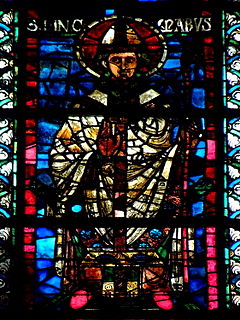
Hincmar, archbishop of Reims, was a Frankish jurist and theologian, as well as the friend, advisor and propagandist of Charles the Bald. He belonged to a noble family of northern Francia.
Bernard II was the count of Barcelona, Girona and margrave of Gothia and Septimania from 865 to 878.
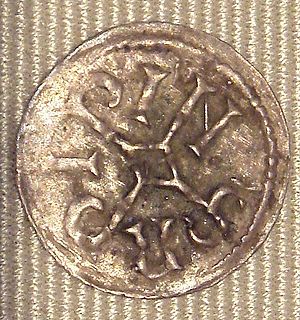
Pepin II, called the Younger, was King of Aquitaine from 838 as the successor upon the death of his father, Pepin I. Pepin II was eldest son of Pepin I and Ingeltrude, daughter of Theodobert, count of Madrie. He was a grandson of the Emperor Louis the Pious.
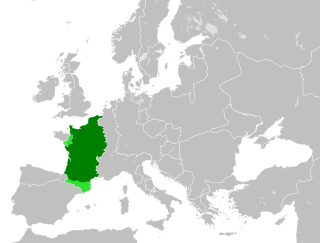
In medieval history, West Francia or the Kingdom of the West Franks refers to the western part of the Frankish Empire established by Charlemagne. It represents the earliest stage of the Kingdom of France, lasting from about 840 until 987. West Francia emerged from the partition of the Carolingian Empire in 843 under the Treaty of Verdun following the death of Charlemagne's son, Louis the Pious.
Waiofar, also spelled Waifar, Waifer or Waiffre, was the last independent Duke of Aquitaine from 745 to 768. He peacefully succeeded his father, Hunald I, after the latter entered a monastery. He also inherited the conflict with the rising Carolingian family and its leader, Pepin the Short, who was king of the Franks after 751 and thus Waiofar's nominal suzerain.

The Archdiocese of Bordeaux (–Bazas) is a Latin Church ecclesiastical territory or archdiocese of the Catholic Church in France. The episcopal see is Bordeaux, Aquitaine. It was established under the Concordat of 1802 by combining the ancient Diocese of Bordeaux with the greater part of the suppressed Diocese of Bazas. The Archdiocese of Bordeaux is a metropolitan see, with four suffragan dioceses in its ecclesiastical province: Dioceses of Agen, Aire and Dax, Bayonne, and Périgueux.

Rodulf was the archbishop of Bourges from 840 until his death. He is remembered as a skillful diplomat and a proponent of ecclesiastical reform. As a saint, his feast has been celebrated on 21 June.
Jordan of Laron was the Bishop of Limoges from 1023 until his death in 1051. He came from a family of well-connected lower nobility, the Laron clan of Noblac. His relative and namesake Jordan was the first Bishop of Poland.
Wulfad was the archbishop of Bourges from 866 until his death. Prior to that, he was the abbot of Montier-en-Der and Soissons. He also served as a tutor to Carloman, a younger son of King Charles the Bald. Carloman succeeded Wulfad as abbot of Soissons in 860.
Wenilo was the archbishop of Sens from 836 or 837. Prior to becoming bishop, Wenilo was a palatine chaplain. As bishop, he was one of the leading men in Aquitaine and crowned Charles the Bald king in 848, definitively uniting Aquitaine with West Francia. In 858, he supported the East Frankish invasion and was denounced as a traitor by the king. He reconciled the next year, and retained his office until his death. Nevertheless, Wenilo passed into legend as Ganelon, the archvillain of the Matter of France, his name a byword for "traitor".
Stodilo was the bishop of Limoges from the early 840s until his death. His unusual name may be a corruption of the Latin stolidus, a humble reference to Christian "foolishness" in the eyes of unbelievers.
Ragenar was the bishop of Amiens from 830 to 833 and again from 834 until his death in 849. His predecessor, Jesse, was initially deposed by the Emperor Louis the Pious in 830 for conspiring with his rebellious son Lothair. In 833 he was restored when Lothair forced his father to make public obeisance at an assembly in Soissons. When Louis regained his position in 834, Jesse was again deposed and this time exiled to Italy, where he died in 836.
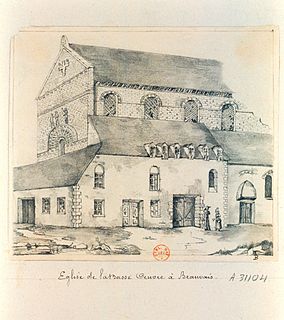
Odo I was a West Frankish prelate who served as abbot of Corbie in the 850s and as bishop of Beauvais from around 860 until his death in 881. He was a courtier and a diplomat, going on missions to East Francia and the Holy See.
Viking incursions into Gascony began with a first raid in 840 and ended in 982 with the battle of Taller.